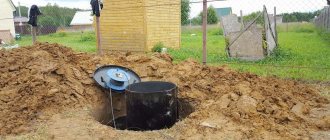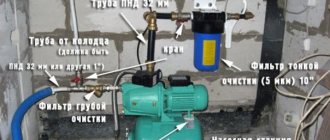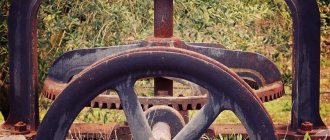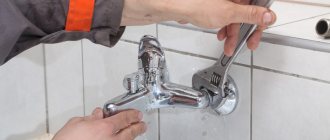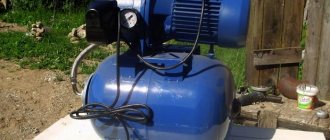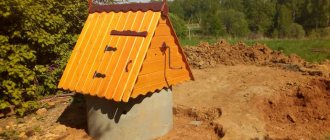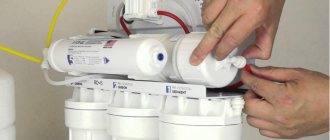Water wells have a limited lifespan. An artesian well will last longer than a water well, but also not indefinitely. It is extremely rare for a water source to dry up completely and suddenly. This phenomenon is associated with the disappearance (draining) of the aquifer, and in this case it is impossible to do without expensive deepening of the well. But much more often we are talking about gradual regression of the source: a noticeable drop in productivity, deterioration in water quality. In this case, there is a high probability that he can be revived. There are companies that provide similar services, but you can try to restore the well yourself.
Device
- Casing. Serves as a sleeve for installing pumping equipment. Made from metal, plastic and polyethylene pipes. Each section is fastened together with a threaded connection or a weld.
- Bottom filter. It is located at the very bottom and protects the water layer from silt or soil entering the trunk.
- A filtration layer of large pebbles is poured along the entire length of the aquifer. To make a pie - soil, a layer of pebbles or crushed stone, casing.
- A chamber or well is constructed in the upper part of the well for installation of equipment and unhindered access to shaft maintenance. The well must be installed to the depth of soil freezing in order to protect the source from the cold in winter.
- Pumping equipment is located inside the upper chamber or in a remote room, but is also part of the aquifer well.
- Pipeline for supplying water to the filtration system and beyond.
- Coarse and fine filters. They are installed after the pump and are the last barrier for small particles before delivery to the consumer.
Important information about the well filter
When cleaning the well, it is important to be careful, otherwise you can accidentally destroy the filter, especially if water hammer is used. If the filter was cleaned with chemicals, the water quality will inevitably deteriorate. Don't worry. This is a temporary phenomenon.
Gradually, the well will be cleared of chemicals, and the water will again become of high quality. To prevent the reagents from having a negative impact on health, you should pump water from the well for 12 hours and stop using it for domestic purposes for a couple of days. You should also install good filters in your home and not use unfiltered water for drinking or cooking until it is purified.
When chemically cleaning a well filter, substances are used that are used in the food industry, so it is generally accepted that they are safe. However, you should always keep the quantity in mind. The concentration of chemicals in the water after cleaning is too high. Reasonable precautions must be taken to avoid poisoning.
The initial purification of groundwater from mineral particles is carried out by a well filter. It is arranged throughout the entire thickness of the aquifer plus half a meter above and below (+)
In addition to chemical filter cleaning, you can use mechanical cleaning. This method is safe and does not affect water quality. To clean the filter from deposits, use a metal device that looks like a regular bottle brush, but is much larger.
Simultaneously with the brush, you can also use cleaning by pumping water. But you should always be aware of the risks. The filter may not withstand the additional pressure and may collapse. It's better not to experiment unless absolutely necessary.
What malfunctions can there be
Earth layers at a depth of 20 meters are in constant motion. The shaft passes through three or four layers and is a foreign object in the earth's crust. Therefore, during natural movement, the trunk is constantly exposed to pressure from different sides and at different depths. Types of faults:
- A sharp or gradual decrease in the flow rate of the source. This happens when sand or silt gets into the water. The pump cannot cope with the thick fraction and becomes clogged. The water supply stops or comes in jerks with dirt. Fluid supply equipment is broken. Lowering the water level in the barrel, the pump is located higher.
- Violation of tightness in the places where pipes connect to each other. Due to improper installation or during long-term operation of the well, actual depressurization of the joints occurs. High water rushes into the cracks, carrying soil deposits with it. The result is a mixing of drinking water and groundwater with sand and clay.
- Broken deep well pump. Failure of water supply equipment to the surface during constant and long-term use of water resources.
- Failure of the filter at the bottom of the source. The breakdown is one of the most difficult in terms of well reconstruction. Large and small stones getting into the filter mesh, silting, partial and complete destruction.
- Displacement of pipe axes due to improper installation or operation in difficult geological conditions. As a result of the movement of layers, coaxiality is lost in them. Separation of components from each other with loss of tightness and violation of the integrity of the shaft leads to a narrowing of the diameter and gradual clogging of the well.
- Poor quality of drilling and installation of the source and equipment. Poor qualifications of workers carrying out work with the casing entail inevitable problems and breakdowns during operation. This is most often associated with an attempt to save money and hire cheaper labor.
- Siltation, sand getting into the mine. The blockage occurs gradually, so diagnosing the problem is difficult. Detection occurs when the pump is completely immersed in the ground and it will be more difficult to get it out.
- Aquifer depletion. Drilling is carried out after geological exploration, during which the depths of water horizons are revealed. During drilling, when passing through several layers, workers must take measures to sufficiently separate each layer from each other to avoid mixing of water layers. Otherwise, the vein will dry out - the liquid will go into the voids below the level.
- Broken deep-well pump support cable. A submersible apparatus is used as a tool for supplying water; the cause of the malfunction may be a break in the suspended equipment. The cable broke and the device fell to the bottom, without necessarily disconnecting the hose. Its elasticity allows the hose to stretch up to a distance of one meter.
- Formation of holes in the liner due to destruction from corrosion or the appearance of holes from impacts. There can be a lot of them along the entire length of the sleeve, especially if the source is not new. This happens due to the aggressive environment in which the trunk is located. Constantly hitting the shaft housing with a pump when lifting it for cleaning can lead to the formation of holes.
- Plaque on the walls of the trunk. Complex chemical processes are constantly occurring in the well. The result of mixing various elements is the formation of limescale on the pipe walls.
Common well failures
If you abandoned a well because you no longer needed a large amount of water, then such a well is the easiest to restore. To do this, you will need to conduct water tests, rinse and clean the well, and, if necessary, use a special chemical reagent.
Attention! After using the reagent, the water quality deteriorates. You will need 12 hours to flush the system, after which the water can be consumed unless other recommendations are indicated on the reagent packaging.
If your well breaks down, and for lack of funds or time you abandon it. The first step is to contact specialists who will conduct a full inspection of the well and diagnose all systems. They can easily determine the cause of the hydraulic structure malfunction and offer you solutions. The most common breakdowns are:
- Clogging;
- Malfunction of the pump;
- Wear of well string pipes;
- Errors about the installation or design of a well.
First of all, you need to find out the cause of the breakdown.
To solve these problems on your own, first you will need to conduct diagnostics and determine what kind of malfunction led to the failure of the entire system.
In these cases it will not be possible to repair
Errors that were made during drilling that affect the quality of the source in the future include the following:
- the wrong height for installing the mesh filter was chosen - the water layer is located below the mesh and the walls block it from entering the trunk;
- drilling was carried out without exploration and stopped in the upper layers, where a small amount of water resources is concentrated;
- there is no gravel filter filling the lower layers of the mine.
Important: the company that carried out the drilling work is required to provide a guarantee for the use of the source for a period of up to five years.
We determine the location and repair it ourselves
Symptoms: the liquid has changed color or taste.
The composition contains impurities of silt or sand, and a persistent swamp smell has appeared.
Diagnostics
The reason for the incorrect operation of the source is a violation of the tightness at the pipe joints. Mixing of perched water and drinking water occurs. Dirty liquid, silt or sand leaks through cracks, crevices, and pipe openings. The filter does not cope with its duties - small particles enter the pump and are sent to the water supply system. Holes appeared in the barrel as a result of corrosion or an impact on the cartridge case.
What to do
Templating, identifying the location of a hole or gap. Special equipment is immersed into the shaft to determine the depth and size of the hole.
You can lower a miniature video camera with a flashlight inside and view the entire depth of the pipe in real time. A special template is adjusted to a specific pipe diameter and loaded into the source under pressure. Difficulty in passing the template is due to displacement of the axes or the formation of plaque on the pipe walls.
Cleaning walls from plaque. A special scraper is immersed, which from the very bottom, gradually rising, scrapes and pulls out all the deposits from the walls. The procedure is repeated several times until the inner surface of the casing is completely cleaned.
Important: the cleaning rod must not be rotated to remove plaque from the walls.
Installing a special metal patch at the site of the hole. Installation takes place using special tools, hooks, conical expanders and hydraulic presses. The patch itself looks like a pipe with longitudinal perforation.
It is secured to the rod above the release head, keeping the patch from falling into the barrel. When the patch reaches the work site, the head, using a hydraulic press, opens the edges of the coupling and plugs the hole. The sealing compound with which the outer surface of the patch is treated ensures a tight fit to the pipe wall and seals the hole. At great depths, two layers of couplings should be installed. The narrowing of the pipe diameter is only 15 millimeters.
Preventive actions
It is much easier to prevent serious equipment breakdowns than to subsequently contact specialized specialists, perform shaft diagnostics and repair casing pipes with installed pumps. First of all, the homeowner will need to take care of using high-quality, durable equipment that ensures the functioning of an autonomous water supply. Saving on installed pumps and filter columns and the use of lightweight plastic pipes may subsequently result in the need to drill again or resort to expensive equipment restoration.
Production wells, including sand and artesian wells, will need to be flushed and pumped on a regular basis to remove sand, silt and other contaminants.
For this flush you can use the following:
- powerful submersible pumps;
- compressor for 12 atmospheres;
- special washing installations.
In a mandatory case, such flushing and other maintenance work will be required if the well is used seasonally or the water supply system operates with long interruptions. If all the equipment operates almost every day, then such preventive maintenance will be required no more than once every five years.
A typical malfunction of any type of well is the entry of foreign objects into the shaft. It is extremely simple to prevent this: an additional metal or plastic mesh is installed on the outlet hole, which can be easily dismantled, while protecting the barrel from possible contamination.
Also effective prevention of malfunctions is maintaining water-lifting equipment in technically sound condition. It will be necessary to regularly check the condition of pumps and filter columns, which may fail during operation, requiring repair or maintenance. Most often, problems are noted with caissons and return filters, especially in not too expensive installations where these elements need to be changed every 3-5 years.
Equipment
- Self-repair.
- Involvement of an organization specializing in this.
In the first case, you yourself will be able to repair simple equipment, for example, get a submersible pump and repair or replace it. Clean the casing from silt and sand with a bailer and hydropneumatic flushing. The work may drag on for several days or even weeks, during which time the house will remain without water.
You will have to turn to professionals if the breakdown occurs at great depths or its correction cannot be done without the use of special means. Companies that specialize in drilling and repairing water wells have all the necessary tools to troubleshoot problems. In addition, experience is of great importance in this matter.
Causes of siltation
In fact, there are quite a few reasons for source pollution. And if it has arisen, then it is advisable to find out. Because cleaning only eliminates the consequences.
Causes of siltation:
- Rare use of a well is a common reason, especially typical for those who do not live in the house permanently. Due to infrequent pumping, the water stagnates and sediment falls out of it;
- the use of vibration pumps - in general, this type of equipment is not recommended for wells. Because due to vibration, destruction of the casing pipe can occur, and in addition, the penetration of contaminants into the source increases;
- the pump is installed at the wrong depth - if it is too high, a settling zone will form under it, and it will quickly silt;
- errors during drilling and well development - if the work is carried out by non-professional employees, problems subsequently arise;
- The bottom hole and the bottom of the source are not insulated - if the casing has not been lined around the casing, this leads to the penetration of foreign particles into the casing.
Thus, source contamination can be caused by many reasons. Even inconsistent water intake can lead to siltation.
Contamination of the casing
Types of repairs
- Current. We must not forget about constant monitoring of the correct operation of the equipment and the source itself. Once a year, any well undergoes a full inspection, signs of failure and the causes of their occurrence are determined. Based on the results of the examination, conclusions are drawn about the need for cosmetic repairs of parts. Sealing the seams of the chamber in the upper part of the shaft. Cleaning or replacing mesh filters.
- Unscheduled, emergency repair of a water well is necessary when the main elements have become unusable. This includes grouting work. Installing a cuff on a leaky section of pipe, returning displaced pipes to their places.
- Major repairs are carried out with long-term use of the source. After 10–12 years, the aquifer is depleted, the filters become clogged, and the flow rate of the source is significantly reduced. During the work, actions may be taken to remove old casing and install new ones. Laying an updated pipe of a smaller diameter into an old sleeve.
Maintenance Tips
- Use only centrifugal pumps instead of vibration pumps.
- Regular inspection and washing of the mine shaft (at least once a year).
- Installing bottom filters will ensure the unhindered passage of clean water.
- Place septic tanks or cesspools as far as possible from the source.
- Pumping the source immediately after drilling and the winter period.
By following all the recommendations, the well is guaranteed to last for more than five years. The artesian has an even longer service life, up to 17–20 years. Subject to proper use and care.
